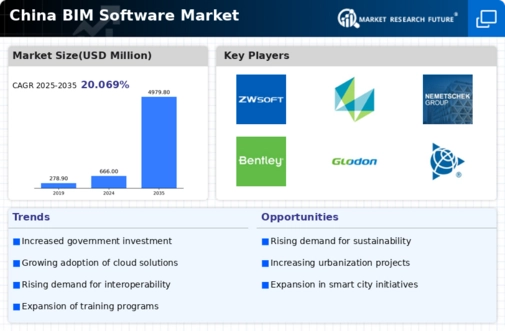Growing Demand for Skilled Workforce
The increasing complexity of construction projects in China has led to a growing demand for a skilled workforce proficient in bim software. As the industry evolves, companies are recognizing the necessity of training programs to equip employees with the skills needed to leverage these advanced tools effectively. Reports suggest that firms investing in workforce development see a 20% increase in project success rates. This emphasis on skill enhancement not only supports the growth of the bim software market but also ensures that the workforce is prepared to meet the challenges of modern construction practices.
Increased Focus on Project Efficiency
In the competitive landscape of the construction industry, the need for enhanced project efficiency is paramount. Companies are increasingly turning to bim software to reduce costs and improve timelines. Studies indicate that projects utilizing bim technologies can achieve up to a 30% reduction in project delivery times. This efficiency is crucial in a market where margins are often tight. As firms seek to optimize their operations, the The BIM software market is likely to grow., driven by the demand for tools that facilitate better planning, coordination, and execution of construction projects.
Government Initiatives and Regulations
The Chinese government has been actively promoting the adoption of advanced technologies in construction, which significantly influences the bim software market. Initiatives such as the '13th Five-Year Plan' emphasize the need for modernization in the construction sector. Regulations mandating the use of digital tools in public projects are becoming more prevalent, thereby driving demand for bim software. In 2023, it was reported that approximately 60% of public construction projects in China are now required to utilize digital modeling technologies. This regulatory push not only enhances project efficiency but also aligns with national goals for sustainable urban development, creating a robust environment for the bim software market.
Technological Advancements in Software Solutions
The The BIM software market is experiencing technological advancements. that are reshaping the industry. Innovations such as artificial intelligence, machine learning, and augmented reality are being integrated into bim solutions, enhancing their capabilities. These advancements allow for more accurate modeling, real-time collaboration, and improved visualization of projects. As firms in China adopt these cutting-edge technologies, the demand for sophisticated bim software is expected to rise. The market is likely to evolve rapidly, with software providers continuously enhancing their offerings to meet the changing needs of the construction sector.
Rising Urbanization and Infrastructure Development
China's rapid urbanization continues to be a key driver for the bim software market. With over 60% of the population now residing in urban areas, the demand for infrastructure development is unprecedented. The government has allocated substantial budgets, estimated at over $1 trillion, for urban infrastructure projects over the next decade. This surge in construction activities necessitates the use of advanced bim software to streamline project management, enhance collaboration, and improve overall efficiency. As cities expand and new projects emerge, the bim software market is poised to benefit significantly from this ongoing trend.





















Leave a Comment